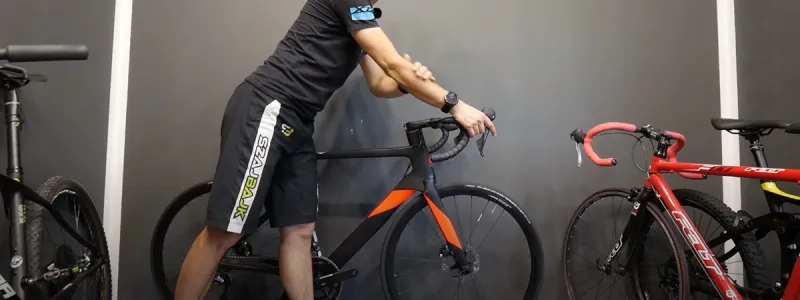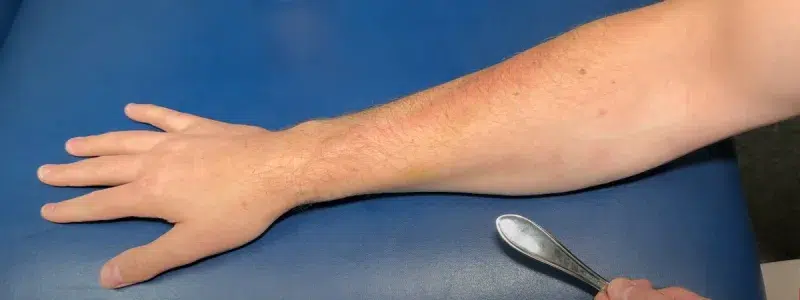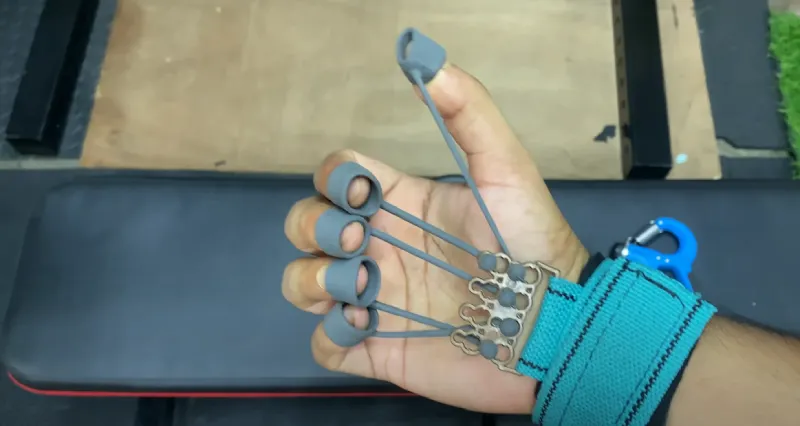You can overgrip the handlebars when cycling, which will cause overuse injuries to your forearms or compression of your ulnar nerve if you don’t position your grip correctly. You may feel pain in your wrist or forearm or even numbness in your hand.
Forearm pain can occur for many reasons, including overuse, nerve entrapment, and arthritis. It depends on the cause, but applying warm or cool packs, taking pain relievers, and immobilizing the joint may help.
We’ll dive into the common causes of forearm pain in cyclists, the risks associated with this type of pain, and effective ways to prevent and treat the issue.
Forearm Pain Cycling: 12 Common Causes
Suppose you’re dealing with forearm pain while cycling. It can take away from the enjoyment of your rides. We explore the most common causes of cycling forearm pain and offer solutions to alleviate the discomfort.
Implications of Correct Cycle Fit for Forearm Pain
Proper cycle fit is crucial to preventing forearm pain. If your cycle is not adjusted to your body’s proportions, you may experience discomfort in your forearms. Here are some factors to consider when fitting your cycle:
- Saddle height: Ensure that your saddle is at the correct height. If your saddle is too low, you’ll put more weight on your arms, leading to forearm pain.
- Handlebar height: Adjust your handlebar height to a comfortable position. If your handlebars are too low, you’ll put more pressure on your forearms, leading to discomfort.
- Reach: Ensure your cycle’s reach is appropriate for your body type. A cycle with a long reach can put more strain on your forearms.
Overuse Injuries and Contributing Factors
Forearm pain can also result from overuse injuries. Here are some contributing factors:
- Excessive training: If you train too hard or too often, you may experience forearm pain. Take rest days and gradually increase your training intensity.
- Poor posture: Cycling with poor posture can lead to forearm pain. Make sure your posture is correct and your arms are relaxed when cycling.
- Lack of stretching: Stretching is crucial to preventing injuries. Ensure that you stretch your forearms and wrists before and after each ride.
Grip Technique and Its Relationship to Forearm Pain
Your grip technique can also lead to forearm pain. Here are some tips for proper grip technique:
- Avoid gripping too tightly: A tight grip can strain your forearms. Hold your handlebars firmly but not too tightly.
- Use multiple hand positions: Constantly gripping in the same position can lead to discomfort. Use numerous hand positions to distribute the load and reduce strain on your forearms.
- Keep your wrists straight: Angled wrists can cause discomfort in your forearms. Keep your wrists straight to reduce the strain on your forearms.
Gear for Forearm Pain: Gloves, Shock Absorbers, and Grips
Your cycling equipment can also contribute to forearm pain. Consider these factors:
- Gloves: Gloves with padding can reduce shock and vibration, reducing the strain on your forearms.
- Shock absorbers: Shock absorbers can absorb shock to reduce strain on your forearms. Consider adding a suspension seat post or fork to your cycle.
- Grips: Comfortable grips can reduce the pressure on your forearms. Consider adding ergonomic grips or gel grips to your handlebars.
Forearm Pain from Cycling: 7 Risks
Forearm pain may seem minor, but it can lead to more severe injuries and disrupt your cycling routine. We will look closer at the risks of forearm pain while cycling, including its implications for other injuries, muscle imbalance, and disrupted cycling routines.
Implications of Forearm Pain for Other Injuries
Forearm pain while cycling can lead to other injuries, especially those affecting the wrist and elbow. When you experience pain in your forearms, you may shift your body weight to these areas, leading to strain and overuse injuries. Some common injuries that can result from forearm pain include:
- Wrist fractures: When you experience forearm pain, you may be more likely to fall and break your wrist.
- Tennis elbow: This injury occurs due to overuse of the elbow tendons, resulting in pain and inflammation.
- Carpal tunnel syndrome: Nerve compression in your wrist causes numbness, tingling, and pain.
Back and Neck Pain Caused By Muscle Imbalance
Forearm pain while cycling can also lead to muscle imbalances, which can, in turn, put stress on your back and neck muscles. When you ride with forearm pain, you may compensate by shifting your weight, leading to overuse of specific muscles and the underusing of others. This muscle imbalance can cause pain and discomfort in your back and neck. Some of
the symptoms you may experience include:
- Lower back pain: This is often caused by tightness or spasms in the muscles that support your lower spine.
- Neck pain and stiffness: This is often caused by tension in your neck muscles from prolonged or repetitive activities, such as cycling.
Disrupted Cycling Routines
Forearm pain cycling can also disrupt your routine, limiting your performance and enjoyment. Cycling is not just an exercise but also a lifestyle. When you experience forearm pain, it can take away the joy of cycling and lead to frustration. Here are some facts related to Disrupted Cycling Routines:
- Forearm pain can lead to fatigue and affect your cycling performance.
- Forearm pain can limit the duration and intensity of your cycling activities because of discomfort or pain.
Forearm Pain During Cycling: Prevention
Pain in the forearm can curtail your cycling goals and even derail your riding pleasure. You can prevent forearm pain while cycling by taking a few steps.
The Importance of Proper Cycle Fit
A properly fitted cycle can reduce the strain on the forearms and provide a comfortable riding experience. An improper cycle fit can cause the hands to bear extra weight, leading to forearm pain. Here are a few tips to get started:
Improving Grip Strength and Flexibility
Cycling puts a strain on your hands and forearms, so it’s essential to maintain good hand strength and flexibility. Here are some exercises that can help prevent forearm pain while cycling:
- Grip-squeeze exercises with hand-gripping tools.
- Wrist rotation exercises with small weights.
- Forearm stretching exercises before and after cycling.
- Make sure your seat is appropriately set for your height.
- Adjust the handlebars to align with your body posture.
- Ensure that your cycle’s reach is comfortable and natural for your body.
Accessories and Equipment to Help Absorb Vibrations and Shocks
Cycling on uneven roads or rough surfaces can lead to vibrations that transfer to your forearms, causing pain. Here are some accessories and equipment that can help to absorb that shock:
- Padded handlebar grips.
- Shock-absorbing gloves.
- High-quality tires that feature suspension or shock-absorbing capabilities.
Proper Cycling Technique and Posture
Proper cycling technique and posture can also prevent forearm pain. Here are some tips to keep in mind:
- Relax Your Grip: Keep a relaxed grip on the handlebars to reduce forearm strain.
- Change Your Hand Position Regularly: Change your hand position often to avoid holding the same position for an extended period.
- Keep Your Arms Slightly Bent: Keeping your arms slightly bent and relaxed can help prevent forearm pain.
Cycling Forearm Pain: Treatment Methods
While most cases of forearm pain are not severe, they can still be frustrating and impair your cycling experience. Various treatments and therapies to treat and prevent forearm pain in cyclists will be discussed.
Consulting a Medical Professional
The pain in your forearm requires you to see a medical professional. Consult your doctor to diagnose discomfort and recommend a treatment plan. You should seek medical attention immediately if you have any indication of a severe injury or condition, such as intense swelling or discoloration.
Common Treatments to Relieve Pain
If your forearm pain is not severe, you can try some simple remedies at home to alleviate the pain.
- Resting: Take a break from cycling for a few days or weeks to give your forearm muscles a chance to recover.
- Icing: Apply ice to your forearm several times daily to reduce inflammation.
- Massaging: Lightly massage your forearm muscles or roll them with a foam roller to relieve tension and promote blood
flow. - Anti-inflammatory Medications: Ibuprofen is an over-the-counter medication that can ease pain and reduce inflammation.
Exercises and Therapies to Promote Recovery
While resting and icing can help reduce the symptoms of forearm pain, it is essential to address the root cause of the issue. The following exercises and therapies can promote recovery and help prevent future injuries.
- Myofascial Release: Myofascial release is a therapy that releases muscle and connective tissue tension. Pressure is applied to specific points on the forearm to release knots and increase blood flow to the affected area.
- Nerve Gliding: Nerve gliding is a form of gentle stretching that focuses on the nerves in the forearm. By stretching the nerves, you can alleviate pain and promote healing.
- Strengthening Exercises: Strengthening exercises can prevent injuries by building muscle endurance and reducing strain on the muscles and tendons. Some examples of strengthening exercises for the forearm include wrist curls, towel twists, and grip squeezes.
Conclusion
Cycling is a great way to stay fit, enjoy the outdoors, and clear your head. If you’re experiencing forearm pain cycling, benefit from this great sport. You can keep cycling without discomfort or pain by understanding the causes, risks, prevention, and treatments of forearm pain.
You are taking proper precautions when cycling, such as appropriate cycle fit and grip technique, and using equipment like shock absorbers and gloves is vital. Also, if you experience persistent or severe pain, please consult a medical professional. By following these tips and taking care of your body correctly, you can continue to enjoy cycling for years to come.
FAQs
Does Cycling Benefit Your Forearms?
You crucially use your arms while cycling, even though it’s not considered an upper-body workout. Various grips along the handlebars and a slight bend in the elbow require the upper body, Savage explains. It triggers the muscles in the forearms, triceps, and shoulders.






